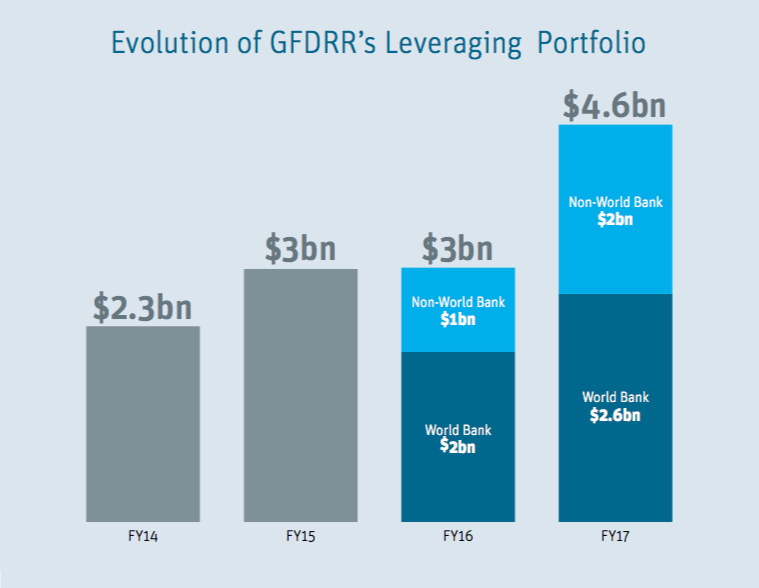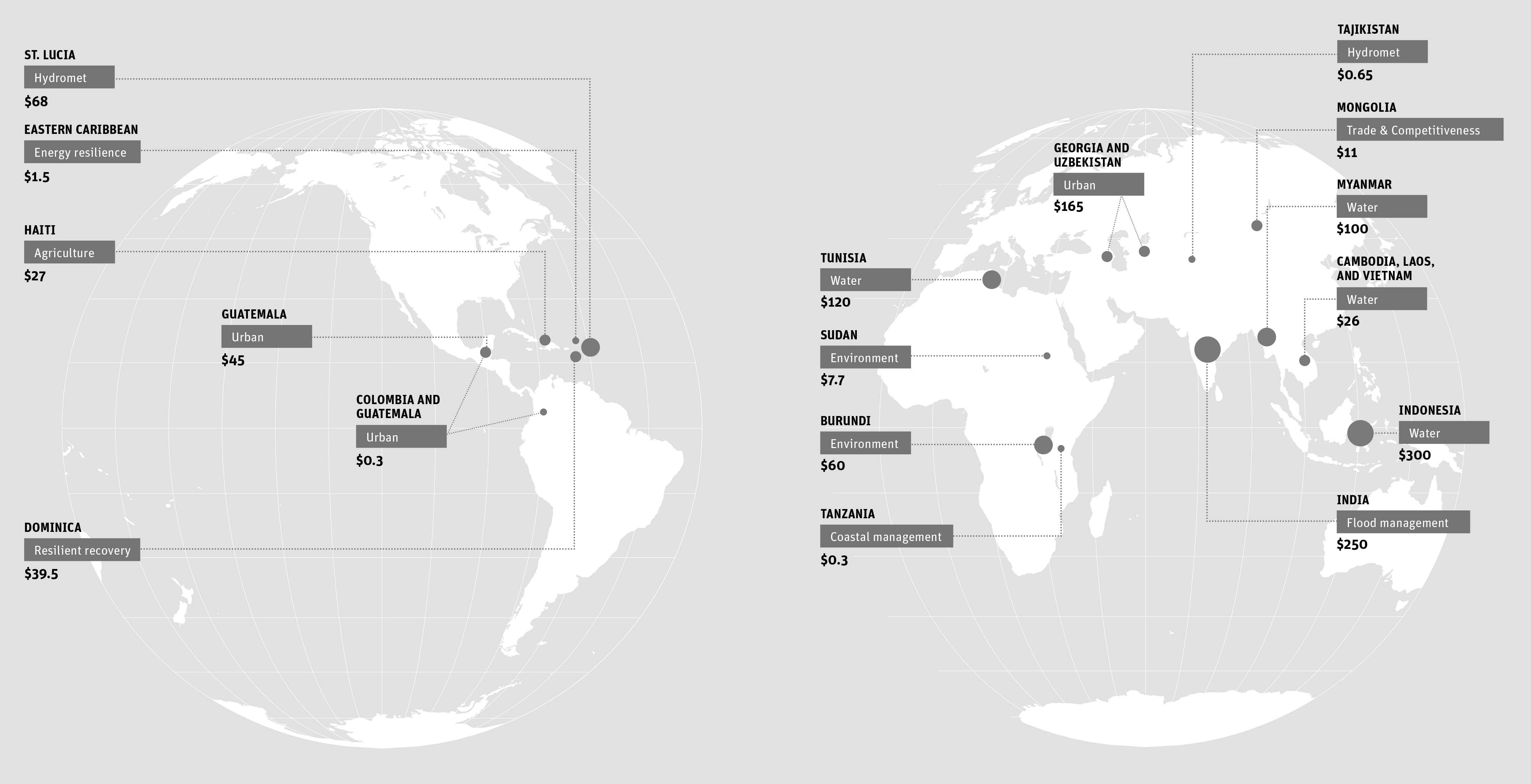STORY HIGHLIGHTS
- The Global Facility for Disaster Reduction and Recovery (GFDRR) enabled close to $5 billion in resilience investments in FY2017, helping over 80 countries become more resilient in the face of natural disasters and climate change.
- GFDRR's latest Annual Report recaps a year of reflection and change, highlighting the Facility's achievements, new initiatives, and progress in its priority areas.
- With investments that aim to make a scalable, sustainable impact, and clear targets that track progress in every sector, GFDRR is tackling the changing landscape of risk.
For the Global Facility for Disaster Reduction and Recovery (GFDRR), fiscal year 2017 was a year of reflection, learning, and growth. Recent disasters have proved that it is more urgent than ever for the world to build resilience to natural disasters - from hurricanes in the Caribbean and drought in Africa, to volcanic activity in the Pacific, flooding in South Asia, and earthquakes in Latin America.
To achieve this goal, the Facility thought big in FY17, focusing on enabling widespread change; took actions to protect lives around the world; and looked ahead to the next steps in global disaster resilience. In FY17, with a grant-making program of $260 million, the Facility leveraged almost $5 billion in resilience funding from its partners, showing a steady growth from previous years. Its achievements and progress are detailed in its newly released 2017 Annual Report.

GFDRR's leveraging has risen steadily, increasing more than 50 percent from FY16 to FY17.
Widespread impact, deep-seated change, long-term results
The challenge of natural disasters, the scale of that challenge, and the urgency of meeting it is clearer now than ever before. In response, "Over the past few years, GFDRR's program gradually shifted to activities that either lead to larger development programs or support policy changes that strengthen institutions for managing risk," says Francis Ghesquiere, Head, GFDRR. That includes enabling large development programs, informing policy reforms, supporting stronger institutions, and formulating new research and initiatives - ones that change the way countries think about becoming more resilient.
For instance, the flagship report Unbreakable reimagined the way we measure disaster losses, introducing a new measurement of how disasters affect people's well-being. A new InsuResilience Global Partnership, with $22 million in pledged support from Germany, aims to strengthen financial resilience - protecting 400 million of the developing world's most vulnerable people from the impacts of climate change. In Indonesia, GFDRR leveraged $1.3 billion in government investments for a national urban upgrade project, and trained thousands of the project's operators and facilitators.
Each of these initiatives, like the rest of GFDRR's work, takes a long-term perspective on disaster resilience and climate change. In FY17, GFDRR formalized, in a forward-looking strategy, this vision of scaling up sweeping impact. The strategy sets ambitious targets in all eight of GFDRR's priority areas, which span every sector affected by disasters. It reflects an evolution of the Facility from a mechanism that financed short-lived pilots to one that enables large development programs.
Increasingly, GFDRR is focusing on integrating both disaster and climate resilience into those development programs. More than three-quarters of GFDRR's new grants last year took into consideration the future impacts of climate change. The Facility's Just-in-Time assistance - small, agile grants of up to $50,000 - also helped integrate climate-resilience measures into about $1 billion in investments in more than 20 countries.

GFDRR's Just-In-Time support helped integrate climate-resilience measures into projects in more than 20 countries, across more than 8 sectors.
Seeing results, envisioning the future
In 2017, its tenth year of operation, GFDRR saw the results of its focus on scale - on smart policies, strong institutions, analytical research, and development programs with widespread impact. Already, 70 percent of GFDRR's new grants in FY17 took gender considerations into account, a number that will continue to increase. A growing program on resilient infrastructure has already made nearly 80,000 classrooms safer, benefiting close to 2 million students. Stakeholders, decision-makers, and project managers can now access 1,500 more risk datasets than they could a year ago. Through its dedicated support to community resilience, GFDRR is benefitting 4 million people. Its engagements in hydromet and early warning systems are reaching 40 million more. In Pakistan, for example, GFDRR is helping design one of the World Bank's largest hydromet projects: a $100 million investment to build capacity, modernize infrastructure, and improve early warning systems.
Inspired by the scale of these results, the Facility is looking ahead to what's next in disaster resilience. Over the last few years, cities have increasingly requested GFDRR's support on large-scale investments. In response, the new City Resilience Program (CRP), supported by GFDRR and the World Bank, will help scale up urban resilience by connecting cities to investors. The program takes advantage of private capital to help bridge the financing gap for resilience projects.
GFDRR's partnerships will continue to be central to the Facility's work. GFDRR helps broaden the conversation around, and encourage action on, disaster and climate resilience by collaborating with a broad array of partners - from governments to academia, civil society to the private sector. In June 2017, for instance, GFDRR co-organized the third World Reconstruction Conference with the African, Caribbean and Pacific (ACP) Group of states, the European Union, and UNDP. More than 500 participants met in Brussels to discuss the role of post-crisis recovery and reconstruction in building resilience.
The landscape of risk is changing rapidly in response to climate change, massive urbanization, and human migration. In 2017 alone, we saw more than $310 billion in global losses and the deaths of about 10,000 people from over 700 natural disasters. Ninety percent of these were extreme weather events - which in 2018 are portended as the largest single risk facing humanity. Efforts to reduce risk and enhance climate adaptation are more relevant and urgent than ever before. GFDRR will continue working with vulnerable countries and its many partners to ensure resilience and development efforts go hand in hand.
